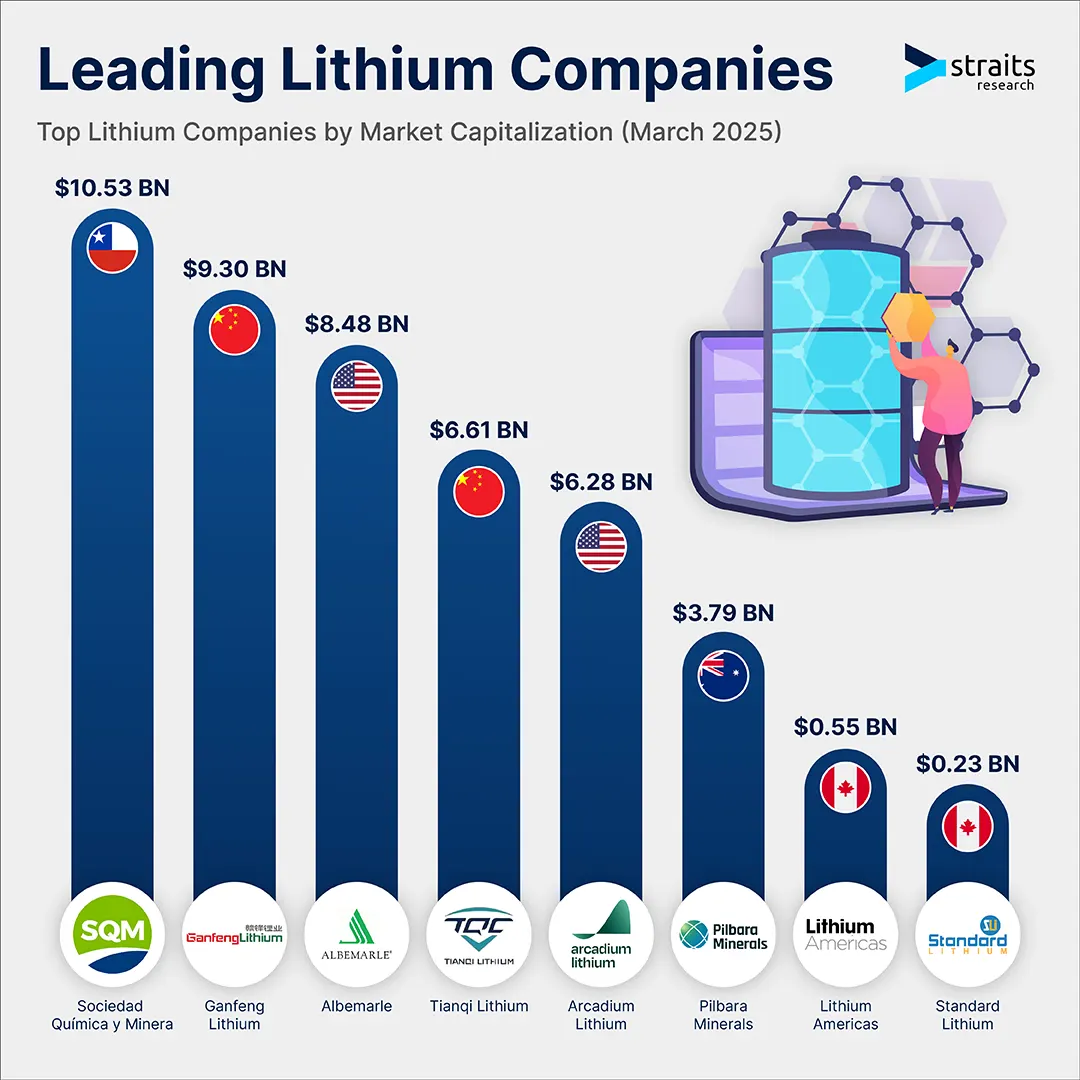8 Largest Lithium Companies by Market Cap (March 2025)

The soft, silvery-white alkali metal lithium has emerged as one of the key components influencing modern technology. Being the lightest metal known, it is used extensively in various industries, including the production of batteries, ceramics, and glass. Lithium is most commonly used in batteries, which power consumer electronics, energy storage devices, and electric vehicles (EVs). Battery manufacture accounted for 87% of total lithium use in 2024, with glass and ceramics coming in second and third, respectively, at 5%. The remaining portion came from other uses, such as air treatment systems and lubricating greases. In the future, it is anticipated that the demand for lithium will increase even further, with batteries accounting for 94% of the supply by 2030.
A 25-fold increase in passenger vehicle demand is driving this growth, which is expected to quadruple the world's lithium demand from 720,000 metric tons in 2022 to 3.1 million metric tons by 2030. The manufacture of lithium is required because of its vital function in lithium-ion batteries, which are necessary for operating portable electronics, storing renewable energy, and powering electric cars. Lithium's significance will only increase as the globe moves toward clean energy technology and a low-carbon future. The demand for lithium carbonate equivalent is expected to rise by 53% from 2023 to over 1.4 million metric tons in 2025. This demand will continue to be primarily driven by the rise in sales of electric vehicles and the need for renewable energy storage.
Leading lithium producers
The global lithium market is dominated by a few key players with the financial resources and expertise to expand production, develop new extraction technologies, and establish strategic partnerships with electric vehicle manufacturers. These companies are crucial in securing a stable lithium supply, particularly given the limited availability and complex extraction process associated with the metal.
With a market cap of $10.53 billion USD as of March 2025, Sociedad química y Minera (SQM) is the market leader in the lithium industry globally. One of the biggest producers of lithium worldwide, the Chilean company contributes significantly to the growing demand for lithium. By 2025, SQM intends to boost its lithium hydroxide and carbonate production in Chile to 100,000 metric tons annually and 240,000 metric tons, respectively. Alongside Albemarle, SQM is set to expand production in the Salar de Atacama, adding between 140,000 and 180,000 metric tons of lithium concentrate equivalent by 2030.
Another significant competitor in the industry is Ganfeng Lithium, a Chinese company valued at $9.30 billion USD. At the Goulamina lithium mine in southern Mali, where the company has started production, 506,000 tonnes of spodumene concentrate are anticipated to be produced yearly in the first phase, and 1 million tonnes in the second. Furthermore, Ganfeng intends to construct the largest facility of its kind in China by constructing a 20 GWh solid-state battery production base in Chongqing.
The US-based Albemarle Corporation, which has a market cap of $8.48 billion USD, is growing its South Carolina-based lithium hydroxide processing plant, which is expected to generate 50,000 metric tons of battery-grade lithium hydroxide each year. With this supply, almost 2.4 million electric vehicles may be produced annually.
Tianqi Lithium of China, valued at $6.61 billion USD, has recently halted construction of a second production line at its Kwinana lithium hydroxide refinery in Western Australia, citing unfavourable market conditions and high costs. Meanwhile, Arcadium Lithium (USA), with a market cap of $6.28 billion USD, is rapidly expanding its operations in Argentina, Canada, and other countries. The company is expected to boost lithium carbonate and hydroxide production by 25% in 2025 and plans further expansions post-2028 that could increase capacity by 125,000 metric tons.
Australian miner Pilbara Minerals, worth $3.79 billion USD, is increasing lithium production through its P1000, P2000, and P680 projects in Western Australia. The P1000 Project, a $560 million expansion, has increased production capacity by 47%, while the P2000 Project aims to boost annual output by over 2 million tonnes.
Smaller players like Lithium Americas (Canada) and Standard Lithium (Canada) have market caps of $0.55 billion USD and $0.23 billion USD, respectively. While they hold a relatively minor market share, they continue to contribute to the global lithium supply, focusing on North American expansion projects.
Top producers are increasing their extraction and processing capacities to meet the expanding demands of the EV and renewable energy sectors as a result of the anticipated spike in global lithium demand. In order to ensure a consistent supply, China and Chile are also increasing their lithium production, even though Australia is still the world's largest producer. Supporting the global shift to sustainable energy solutions will require sustained investment in lithium production, battery technology developments, and industry alliances.




